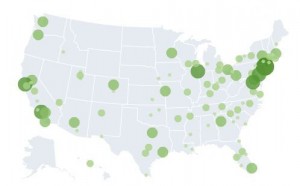by James A. Bacon
In the 1990s, the “it” sector for state and regional economic development was semiconductors. In the 2000s, it was biotech. Today, it’s the “clean, “green,” or low-carbon sector, defined as businesses that produce goods and services with an environmental benefit. Everybody wants a piece of clean tech these days. And now a new Brookings Institution report not only extols the virtues of clean tech but advises state, local and federal governments on how to get more of it.
Clean tech matters for many reasons. It is manufacturing- and export-intensive, it pays well, and it creates opportunities for relatively low- and middle-skilled workers. It rides a wave of global demand, creating long-term growth opportunities. Moreover, clean tech is inherently virtuous: It can help solve the planet’s pressing environmental problems.
In “Sizing the Clean Economy: a National and Regional Green Jobs Assessment,” Brookings suggests that the federal government can encourage clean tech by (1) catalyzing domestic demand for low-carbon and environmentally oriented goods and services; (2) addressing the serious shortage of affordable, risk-tolerant and larger-scale capital that impedes the scale-up of clean economy industry segments; and (3) driving innovation by investing in the clean-economy innovation system.
States can improve the information base about local clean economy industry clusters and support regionally crafted initiatives for advancing them. Regions should seek to understand the local clean economy in detail, identify competitive strengths, and formulate “bottom up” strategies for overcoming constraints to cluster growth.
Before state and local governments jump onto the clean tech bandwagon, however, it helps to know if they are starting from scratch (not such a great idea) or building on existing strengths. According to Brookings, Virginia is not exactly a hotbed of clean-tech innovation. But it’s not a wasteland either. (Click on map to view more legible image of clean sector job clusters.) The main center of innovation is the Washington metro region — no surprise, there — but there are respectable centers of clean-sector activity in the Richmond and Hampton Roads regions.
Virginia has roughly 66,700 clean jobs, ranking it 15th among the 50 states and Washington, D.C. The clean economy contributes 1.7% of all jobs in the state, ranking it only 36th in intensity, however. Annual wages are $43,400 and exports per job are $11,000. (See details in this state profile.)
Take a closer look, and the details are less impressive. Waste management and treatment is our second largest jobs category. Mass transit is third, and “regulation and compliance” is fourth. In other words, we’re counting a lot of waste treatment plant workers, bus drivers and government administrators in our total. “Conservation,” whatever that is, is the No. 1 category. It sounds very Virginian.
The cool categories are pretty underwhelming: 142 jobs in the smart grid segment, 71 in green consumer goods, 103 in biofuels/biomass and 410 in wind. The one broad category that shows some potential is professional environmental services, which employs 4,642.
Maybe I’m getting old and cynical, but I’ve seen these economic development fads come and go. As a contrarian by nature, I’d be wary of chasing after the same limited number of companies and deals that everyone else is lusting for. Better to focus our attention on some under-appreciated or out-of-favor sector — like logistics, medical devices, or nuclear power — where a little bit of love goes a long way.



